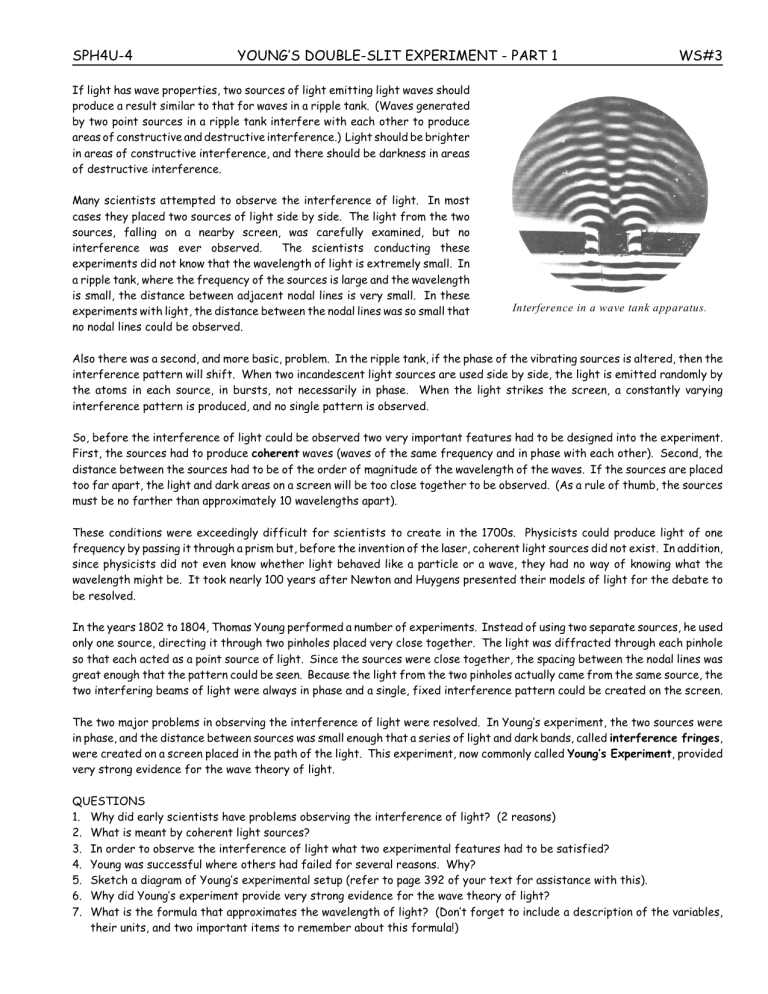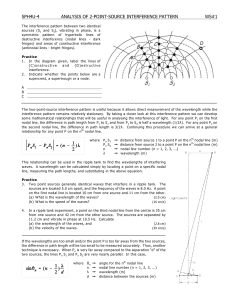Young's Double-Slit Experiment Worksheet

SPH4U-4 YOUNG’S DOUBLE-SLIT EXPERIMENT - PART 1 WS#3
If light has wave properties, two sources of light emitting light waves should produce a result similar to that for waves in a ripple tank. (Waves generated by two point sources in a ripple tank interfere with each other to produce areas of constructive and destructive interference.) Light should be brighter in areas of constructive interference, and there should be darkness in areas of destructive interference.
Many scientists attempted to observe the interference of light. In most cases they placed two sources of light side by side. The light from the two sources, falling on a nearby screen, was carefully examined, but no interference was ever observed. The scientists conducting these experiments did not know that the wavelength of light is extremely small. In a ripple tank, where the frequency of the sources is large and the wavelength is small, the distance between adjacent nodal lines is very small. In these experiments with light, the distance between the nodal lines was so small that no nodal lines could be observed.
Interference in a wave tank apparatus.
Also there was a second, and more basic, problem. In the ripple tank, if the phase of the vibrating sources is altered, then the interference pattern will shift. When two incandescent light sources are used side by side, the light is emitted randomly by the atoms in each source, in bursts, not necessarily in phase. When the light strikes the screen, a constantly varying interference pattern is produced, and no single pattern is observed.
So, before the interference of light could be observed two very important features had to be designed into the experiment.
First, the sources had to produce coherent waves (waves of the same frequency and in phase with each other). Second, the distance between the sources had to be of the order of magnitude of the wavelength of the waves. If the sources are placed too far apart, the light and dark areas on a screen will be too close together to be observed. (As a rule of thumb, the sources must be no farther than approximately 10 wavelengths apart).
These conditions were exceedingly difficult for scientists to create in the 1700s. Physicists could produce light of one frequency by passing it through a prism but, before the invention of the laser, coherent light sources did not exist. In addition, since physicists did not even know whether light behaved like a particle or a wave, they had no way of knowing what the wavelength might be. It took nearly 100 years after Newton and Huygens presented their models of light for the debate to be resolved.
In the years 1802 to 1804, Thomas Young performed a number of experiments. Instead of using two separate sources, he used only one source, directing it through two pinholes placed very close together. The light was diffracted through each pinhole so that each acted as a point source of light. Since the sources were close together, the spacing between the nodal lines was great enough that the pattern could be seen. Because the light from the two pinholes actually came from the same source, the two interfering beams of light were always in phase and a single, fixed interference pattern could be created on the screen.
The two major problems in observing the interference of light were resolved. In Young’s experiment, the two sources were in phase, and the distance between sources was small enough that a series of light and dark bands, called interference fringes , were created on a screen placed in the path of the light. This experiment, now commonly called Young’s Experiment , provided very strong evidence for the wave theory of light.
QUESTIONS
1. Why did early scientists have problems observing the interference of light? (2 reasons)
2. What is meant by coherent light sources?
3. In order to observe the interference of light what two experimental features had to be satisfied?
4. Young was successful where others had failed for several reasons. Why?
5. Sketch a diagram of Young’s experimental setup (refer to page 392 of your text for assistance with this).
6. Why did Young’s experiment provide very strong evidence for the wave theory of light?
7. What is the formula that approximates the wavelength of light? (Don’t forget to include a description of the variables, their units, and two important items to remember about this formula!)



